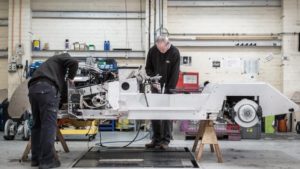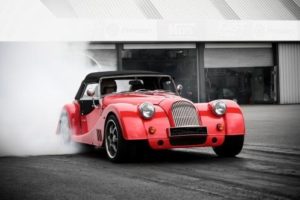[This is an older article however it features a MOGSouth Member, Ellis King, so we just have to have it posted on the web site. Enjoy. Mark]
When people talk about sports car “purity,” we usually roll our eyes and simply embrace the notion that if a car is fun, it’s fun. Period.
But the Morgan aficionados who say such things might just have a point.
Take a look at the 2005 Morgan Roadster on these pages. Most non-Morgan fans would be hard pressed to tell you if this car was from 1965 or 2005. Sure, up close, we could recognize the airbag-equipped steering wheel and the thoroughly modern, electronically fuel-injected, overhead-cam engine under the hood, but in its most basic form, the Roadster looks–and acts–just like cars the company made some 50 years ago. It even has the same sliding-pillar front suspension first used before World War II.
After phasing out the Rover V-8-powered Plus 8 in 2004 as it introduced the slick BMW-powered Aero 8, Morgan announced a new model that was simply called the Roadster, clearly inspired by the Plus 8 and Plus 4 that came before it. Morgan earmarked 82 model year 2005 cars for the U.S. market, equipping the cars with airbags, among other details required by federal regulations. Under the hood, in place of the Rover V-8, Morgan installed a Ford Duratec 3.0-liter V-6 as used in the U.K. Ford Mondeo ST220.
Built on a steel ladder frame with a body of aluminum reinforced with wood, the Roadster shows that traditional, small-batch coachbuilding is indeed alive and well in the 21st century. The Roadster may have been built with air conditioning, but it has no proper side windows, just curtains. Its fenders sit well proud of the body, connected front to rear via running boards. Even the round headlamps are affixed between those “wings” and the bonnet. It’s all very old school, but calling it retro would neglect the fact that Morgan never went back to anything. Instead, they have simply maintained tradition and technique.
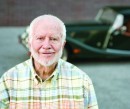
Ellis King, a retired professor of civil engineering at the University of North Carolina at Charlotte, owns the Roadster featured here. As a longtime owner of various English sports cars, Ellis has worked out his own feelings of what he thinks a sports car should be. “I think, first, that you can drive and feel like you’re driving something, that’s part of it,” he says. “It’s something that you feel comfortable in and you feel like you can do almost anything you want within your own capabilities and the car is going to do it for you. It’s something that has classical lines to me that looks like my idea of a sports car. It doesn’t mean it has to look like a Morgan, but classical lines means the older MGs, even MGAs, MGCs, MGBs–those truly look like sports cars.”
Morgan clearly had this “sports car” thing down for decades, so, even with the advent of the newer BMW-powered Aero 8, it needed an engine to power the classically designed Roadster. Of course, Morgan has had a long history of procuring off-the-shelf engines from other manufacturers, including sourcing them from the likes of Standard, Triumph, Fiat, Rover and Ford.
The company had great success selling the Plus 8, powered by Rover’s all-aluminum, pushrod V-8. By the time Morgan produced the last models powered by this legendary powerplant, it displaced 4.6 liters and made a healthy 220 hp and 260-lb.ft. of torque. But Rover made the last of these engines in 2004, ending a remarkable run that started when the company bought the rights to the engine from General Motors in January 1965.
When Ford began developing the Mondeo sedan in the late 1980s (to be called the Contour in the U.S.), the intention was to build its first true “world” car that would be virtually the same no matter in which country it was sold, with only small localization efforts to minimize costs. Ford split the engineering up between groups in the U.S., U.K. and Germany. While one group developed the chassis, one the body and another the interior, the V-6 engine program almost became an orphan, its development not budgeted with any Ford engineering center at the time. Until the Blue Oval turned to Porsche for assistance, that is.
Porsche has a long history of acting as consulting engineers, so its involvement in the development of the Mondeo’s Duratec V-6 should surprise no one. One version of the story says that Porsche had a project of its own making that it sold outright to Ford. Another source tells us that Ford sought out Porsche’s help when internal conflicts left the project without a home at Ford and Porsche completed the engineering of the DOHC, 24-valve engine with Ford’s longtime partners at Cosworth, who know more than a thing or two about multi-valve cylinder heads themselves.
The all-aluminum V-6 started at 2.5 liters, producing 170 hp in U.S. trim in the Contour when it debuted in 1994. The engine became widely used in Ford products, including sedans, small crossovers, Mazdas and even various Jaguars. When Morgan opted for the V-6 as a replacement to the Rover engine in 2005, the 3.0-liter Duratec was rated at 225 hp at 6,200 RPM and 200-lb.ft. of torque at 5,400 RPM. While the torque figure was down quite a bit from the Rover V-8, the lighter, higher-revving Ford engine coupled to a five-speed manual transmission and a limited-slip rear axle proved a robust combination for the 2,070-pound Morgan. Testers reported 0-60 MPH times just over five seconds, a performance level exaggerated by the car’s traditional, open roadster design.
That sort of performance and the modernity of the Ford power-train appealed to Ellis. For many years, he had owned an MGA and an MGC, but he had had his eye on a Morgan, an admittedly acquired taste, for some time. His interest grew after spending time with some Morgan friends and attending their events. He and his wife, Rachel, began looking around at Plus 8s, but were scared off a bit. “It seemed like, every time we talked to someone, they kept saying they had this problem, they had that problem with their Morgans. Rachel was kind of reluctant, to say the least, to get another car that I was going to have problems with. She likes to get to a place and get back and not worry about it.”
When Ellis got wind of the new $73,950 Roadster in 2005, he decided to seriously look into it. “I said to Rachel, ‘If we could get a Morgan that would be dependable, what would you think of that? Why don’t we go take a look at one?’ Naturally, she asked how much it was. She was a little bit surprised. Her comment was, ‘Well, you’re now retiring. You’ve never done anything extravagant in your life like that. But, if you want it, get it and get it fitted out the way it should be.'”
Fitted out “the way it should be” meant Rachel having a big say in ordering “the most Morgan-looking Morgan we could find,” according to Ellis. Rachel chose the colors, Connaught Green for the exterior and a slightly darker-than-usual Muirhead Ingleston Saddle Brown for the leather interior. Ellis and Rachel also chose a host of other options to very much personalize their Morgan, including the machined-aluminum “organ-type” accelerator pedal, Lucas driving lamps, machined “bullseye” bonnet knobs, leather bonnet strap, wind deflectors, a host of stainless steel accessories, the carbon composite hardtop and the practically de rigueur badge bar for club and event affiliation.
That hardtop can only be used when the entire convertible top has been removed, not just lowered, as there is not a whole lot of storage space in the small Roadster. And that’s okay with Ellis, because he has not removed it in some 22,000 miles over the past 10 years of driving it. Only during the delivery process in 2006 as part of a demonstration at the dealership did he ever bother with lowering and raising the soft top. As for storage space, the luggage rack out back–another option–is a practical requirement, and not just for show if you travel with more than just a toothbrush.
Ellis participated in three Carolina Trophy vintage rallies with the Roadster late in the past decade, along with his close friend since childhood, Norris Haynes, who did all of the driving during the timed stages of the week-long, 1,000-mile TSD rally. The twisty mountain roads of the western Carolinas required a lot of arm strength to turn the unassisted Morgan, so Ellis had an electric power steering unit installed, the only modification he has made so far.
Getting a chance to drive Ellis’s Roadster, a mix of modern driveline engineering and traditional chassis and suspension, is not one to pass up. With the keys in hand and Ellis in the passenger seat, I gladly climb into the car. But the Morgan, like many exotic cars, takes some effort to climb in and out of, primarily to get underneath the low steering wheel. The biggest trick for Morgan to import this car to the U.S. involved fitting airbags, which required a substantially different steering column. Though there is clearly a tilting mechanism visible on the exposed parts of the column, it doesn’t work and probably just came with the parts that Morgan needed to fit the airbag.
But back to the driving position. You get low in the Morgan. Very, very low, though the seats are adjustable. Overall, the car’s 56-inch measured height does not quite tell you how low it feels when you get inside. Much like driving a prewar classic, with its long, narrow hood and separate headlamp buckets, the Morgan gives you more than an eyeful looking down its long, louvered aluminum hood. Given the low seating position, the hood looks higher than it is. The wood dash and black-on-white Smiths gauges complete the classic feel.
With the optional hardtop pretty much permanently installed, the view out the back doesn’t offer too much guidance. Apparently, when the folding soft top is installed and lowered, there is even less to see. Good thing the Roadster is fast going forward.
The transmission shifts easily, the clutch takeup as uncomplicated as that on a Honda. “It’s the easiest transmission I have ever driven,” agrees Ellis. The three pedals do have a fairly narrow space to share in the driver’s footwell, however. The beauty, of course, is in the driving. Acceleration in this slightly-more-than-one-ton car is more than brisk and the engine likes to rev.
I would imagine in a 3,700-pound Jaguar S-type or 3,400-pound Ford Taurus, the engine might feel overwhelmed, the typical driver never interested in bringing it beyond 5,000 RPM into the heart of its power band. But in the Morgan, it revs freely. Though there is no redline marked on the tach, Duratec engines are known to have a rev-limiter over 7,000 RPM, which Ellis admits to hitting from time to time. “But I only ever hit in the low gears–and not when Rachel’s in it, either!” he says.
Passing power is bountiful, and we can only imagine how much faster it scoots compared to the original Plus 4 models of the Fifties and Sixties. Road & Track reported a 5.2-second 0-60 time when the Roadster was introduced. Braking feel is nothing special from the front-disc/rear-drum setup, but the binders are effective at scrubbing off speed in our ride, taken on the outer roads of a rather spread-out and not-yet-developed suburban office park, the sort of place where no one bothers you as you tear around a traffic circle on an almost empty road.
Still family owned, as it has been since its founding in 1910, Morgan knows more than a thing or two about building truly bespoke sports cars for a dedicated group of enthusiasts, like Ellis. “I think a lot of people would drive a Morgan and simply not like it because it’s different from other sports cars. If you’re looking truly for a sports car that has all of the features that everyone thinks of a sports car having, then that’s a Morgan.”
OWNER’S STORY
I think this Morgan is the last true sports car. It has the classic body. It has all the power you need. It drives like a sports car should. It looks like a sports car should. I bought this particular one because I wanted a sports car that would be new and dependable. It has been dependable, and it runs good.
I don’t know anything I don’t like about it. It’s got a hard ride, which is a Morgan ride. It drives very well. It’s got plenty of power. I can think of lots of things I like, but I don’t know of anything I don’t like. If I had to answer the question, “Would you change something on it?” I’m not sure I’d change anything. -Ellis King
2005 MORGAN ROADSTER
Engine DOHC V-6 with aluminum alloy block and cylinder heads
Displacement 2,967 cc (181.1-cu.in.)
Bore x stroke 89 mm x 79.5 mm
Compression ratio 10.0:1
Horsepower @ RPM 225 @ 6,200
Torque @ RPM 200-lb.ft. @ 5,400
Main bearings Four
Fuel system Electronic fuel injection
Electrical system 12 volts
Ignition system Coil-on-plug distributorless
Exhaust system Stainless-steel tubular headers; dual-exhaust outlets; catalyst equipped
Gearbox Five-speed manual transmission; single dry-plate clutch
Differential Hypoid gears with limited-slip
Steering Rack and pinion, 3.5 turns lock-to-lock with aftermarket power assist
Brakes Hydraulic dual-circuit with power assist; Front: 11-inch AP discs; Rear: 9-inch drums
Chassis and body Steel frame with Z-shaped main spars and tubular cross members; aluminum body with partial wood frame
Suspension Front: Independent sliding-pillar with coil springs and gas-filled telescopic shock absorbers; Rear: Semi-elliptic leaf springs with gas-filled telescopic shock absorbers
Wheels Stainless steel 72-spoke wire wheels, 16 x 7 inches
Tires 205/55R16
WEIGHTS & MEASURES
Wheelbase 96.1 inches
Overall length 158 inches
Overall width 67 inches
Overall height 56 inches
Front track 50.8 inches
Rear track 56.7 inches
Curb weight 2,070 pounds
CALCULATED DATA
Hp per liter 75.8
Weight per hp 9.2 pounds
Weight per cu.in. 11.43 pounds
PERFORMANCE
0-60 MPH 5.2 seconds (Road & Track)
Top speed 134 MPH (factory claim)
PRICE
Base price (new) $73,950
Price (new) $79,606 (optioned as driven)
Market value (today) Low: $56,700 Average: $71,000 High: $92,000
This article originally appeared in the August, 2016 issue of Hemmings Sports & Exotic Car.
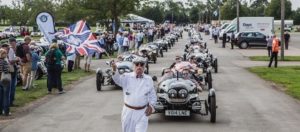

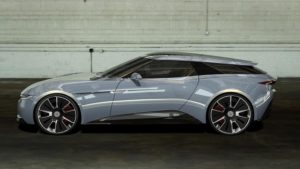
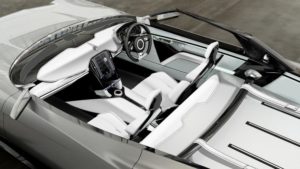
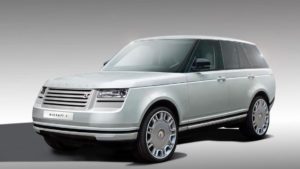

 Summer is here and when the sun shines a young man’s fancy turns to sports cars.
Summer is here and when the sun shines a young man’s fancy turns to sports cars. 
